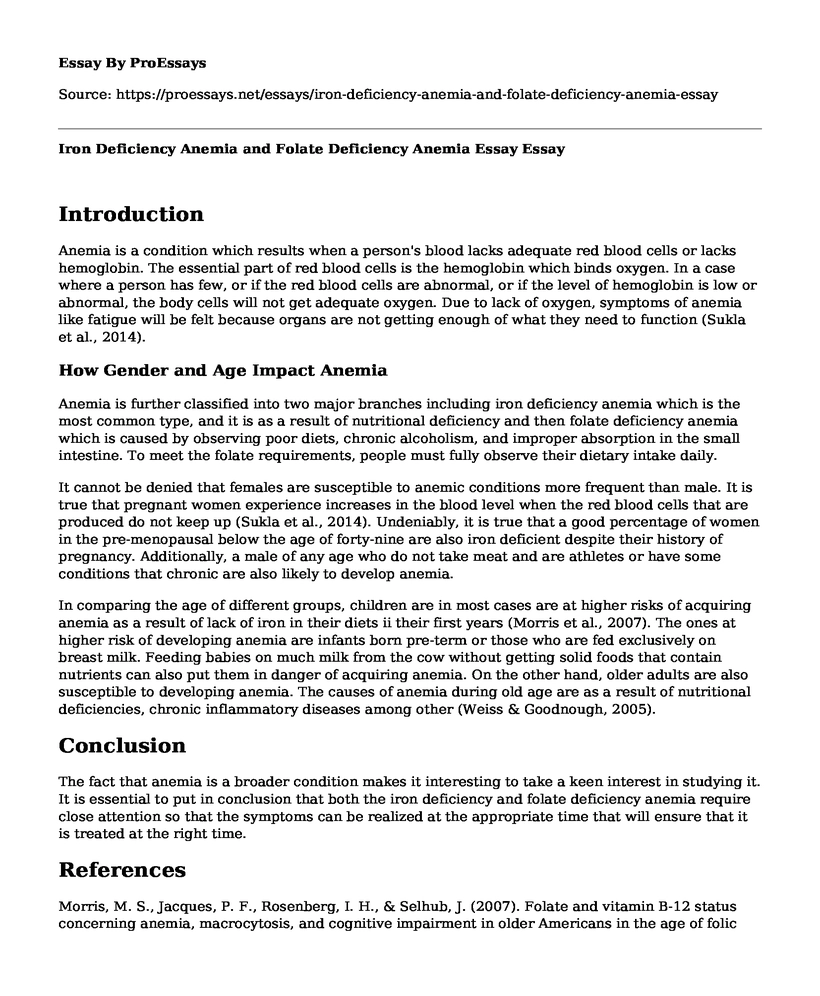Introduction
Anemia is a condition which results when a person's blood lacks adequate red blood cells or lacks hemoglobin. The essential part of red blood cells is the hemoglobin which binds oxygen. In a case where a person has few, or if the red blood cells are abnormal, or if the level of hemoglobin is low or abnormal, the body cells will not get adequate oxygen. Due to lack of oxygen, symptoms of anemia like fatigue will be felt because organs are not getting enough of what they need to function (Sukla et al., 2014).
How Gender and Age Impact Anemia
Anemia is further classified into two major branches including iron deficiency anemia which is the most common type, and it is as a result of nutritional deficiency and then folate deficiency anemia which is caused by observing poor diets, chronic alcoholism, and improper absorption in the small intestine. To meet the folate requirements, people must fully observe their dietary intake daily.
It cannot be denied that females are susceptible to anemic conditions more frequent than male. It is true that pregnant women experience increases in the blood level when the red blood cells that are produced do not keep up (Sukla et al., 2014). Undeniably, it is true that a good percentage of women in the pre-menopausal below the age of forty-nine are also iron deficient despite their history of pregnancy. Additionally, a male of any age who do not take meat and are athletes or have some conditions that chronic are also likely to develop anemia.
In comparing the age of different groups, children are in most cases are at higher risks of acquiring anemia as a result of lack of iron in their diets ii their first years (Morris et al., 2007). The ones at higher risk of developing anemia are infants born pre-term or those who are fed exclusively on breast milk. Feeding babies on much milk from the cow without getting solid foods that contain nutrients can also put them in danger of acquiring anemia. On the other hand, older adults are also susceptible to developing anemia. The causes of anemia during old age are as a result of nutritional deficiencies, chronic inflammatory diseases among other (Weiss & Goodnough, 2005).
Conclusion
The fact that anemia is a broader condition makes it interesting to take a keen interest in studying it. It is essential to put in conclusion that both the iron deficiency and folate deficiency anemia require close attention so that the symptoms can be realized at the appropriate time that will ensure that it is treated at the right time.
References
Morris, M. S., Jacques, P. F., Rosenberg, I. H., & Selhub, J. (2007). Folate and vitamin B-12 status concerning anemia, macrocytosis, and cognitive impairment in older Americans in the age of folic acid fortification-. The journal of clinical nutrition, 85(1), 193-200.
Sukla, K. K., Nagar, R., & Raman, R. (2014). Vitamin-B12 and folate deficiency, major contributing factors for anemia: A population-based study. e-SPEN Journal, 9(1), e45-e48.
Weiss, G., & Goodnough, L. T. (2005). Anemia of chronic disease. New England Journal of Medicine, 352(10), 1011-1023.
Cite this page
Iron Deficiency Anemia and Folate Deficiency Anemia Essay. (2022, Jun 30). Retrieved from https://proessays.net/essays/iron-deficiency-anemia-and-folate-deficiency-anemia-essay
If you are the original author of this essay and no longer wish to have it published on the ProEssays website, please click below to request its removal:
- Course Work Sample: ABC Health Care's Income Performance and Budgetary Recommendations
- Campaign Plan/ Ballot Initiative
- Essay Sample on Energy Drinks: Benefits, Risks and Alternatives
- Essay Sample on Social Work: Promoting Social Cohesion & Wellbeing
- Essay Sample on Health Considerations in Canada's Foreign Policy: Impact of Globalization
- Essay Example: Informed Consent Form: Patient Rights and Obligations
- Paper Example on Facilitating Abortions in the World







